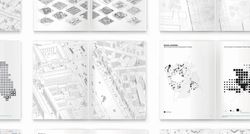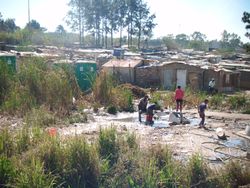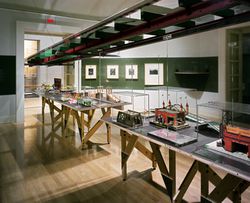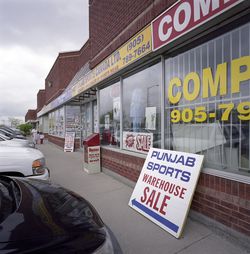Series
Academic work and interviews
AP207.S4
Description:
The series documents Pettena’s academic work and his activities as an architecture critic from the 1970s to the mid 2010s. It documents Pettena’s teaching, including his work as professor of History of Contemporary Architecture at the University of Florence from 1973 to 2008, but also as professor of Design at California State University. It also includes materials related to lectures and conferences he gave either on his work or on subjects he studied, including lectures for the Domus Academy in 1993. The series also documents interviews he gave during his career to promote his projects, his exhibitions or publications, as well as for publications and exhibitions on him and his work. The series contains administrative material related to Pettena’s work as a professor, chiefly at the University of Florence, such as correspondence and course syllabi. The series also includes Pettena’s teaching material, such as notes and reference material, and photocopies of reading assignments for courses. This series also contains a large collection of reference slides, predominantly on contemporary architecture and design and on architects, such as Ettore Sottsass Sr. and Jr., Hans Hollein, Alessandro Mendini, Carlo Scarpa, Oscar Niemeyer, Buckminster Fuller, and Studio Alchimia, as well as on contemporary artistic movements. Also included is student work, such as student theses from University of Florence and one thesis from a student at the California State University. The series also contains materials related to Pettena’s lectures, including correspondence, presentation texts, and promotional material for lectures, seminars and courses. Finally, the series includes material from Pettena’s interviews, such as interview transcripts, copies of published interviews, and audio and video recordings of interviews.
circa 1970-2015
Academic work and interviews
Actions:
AP207.S4
Description:
The series documents Pettena’s academic work and his activities as an architecture critic from the 1970s to the mid 2010s. It documents Pettena’s teaching, including his work as professor of History of Contemporary Architecture at the University of Florence from 1973 to 2008, but also as professor of Design at California State University. It also includes materials related to lectures and conferences he gave either on his work or on subjects he studied, including lectures for the Domus Academy in 1993. The series also documents interviews he gave during his career to promote his projects, his exhibitions or publications, as well as for publications and exhibitions on him and his work. The series contains administrative material related to Pettena’s work as a professor, chiefly at the University of Florence, such as correspondence and course syllabi. The series also includes Pettena’s teaching material, such as notes and reference material, and photocopies of reading assignments for courses. This series also contains a large collection of reference slides, predominantly on contemporary architecture and design and on architects, such as Ettore Sottsass Sr. and Jr., Hans Hollein, Alessandro Mendini, Carlo Scarpa, Oscar Niemeyer, Buckminster Fuller, and Studio Alchimia, as well as on contemporary artistic movements. Also included is student work, such as student theses from University of Florence and one thesis from a student at the California State University. The series also contains materials related to Pettena’s lectures, including correspondence, presentation texts, and promotional material for lectures, seminars and courses. Finally, the series includes material from Pettena’s interviews, such as interview transcripts, copies of published interviews, and audio and video recordings of interviews.
Series
circa 1970-2015
archives
Level of archival description:
Fonds
André Blouin fonds
AP038
Synopsis:
The André Blouin fonds, 1933-1996, documents the professional career of architect André Blouin. Materials in this fonds consist of the following: approximately 4821 drawings (including reprographic copies), 4006 photographic materials, 52 l.m. of textual records, 127 panels and 4 reels of 16 mm film.
1933-1996
André Blouin fonds
Actions:
AP038
Synopsis:
The André Blouin fonds, 1933-1996, documents the professional career of architect André Blouin. Materials in this fonds consist of the following: approximately 4821 drawings (including reprographic copies), 4006 photographic materials, 52 l.m. of textual records, 127 panels and 4 reels of 16 mm film.
archives
Level of archival description:
Fonds
1933-1996
Learning from... Copenhagen
Deane Simpson presents the Atlas of the Copenhagens, a book project addressing an urban territory that has been posited in the media and celebrated by the municipality of Copenhagen as the world’s most sustainable and liveable city. Such claims suggest that Copenhagen is a fitting site to study and engage in a debate on sustainability and liveability. The Atlas operates(...)
Paul-Desmarais Theatre
21 May 2015 , 6pm
Learning from... Copenhagen
Actions:
Description:
Deane Simpson presents the Atlas of the Copenhagens, a book project addressing an urban territory that has been posited in the media and celebrated by the municipality of Copenhagen as the world’s most sustainable and liveable city. Such claims suggest that Copenhagen is a fitting site to study and engage in a debate on sustainability and liveability. The Atlas operates(...)
Paul-Desmarais Theatre
Series
CIAM IV, CIRPAC and London
AP112.S1
Description:
The series contains seven bands of negatives, divided into groups of two and three negatives a band. The first five bands document the 4th Congrès International d'Architecture Moderne (CIAM) held on board the SS Patris II from 29 July to 13 August 1933, as it travelled between Marseilles, France, and Athens, Greece, and then returned. The conference, themed "The Functional City", presented and discussed the results of an analysis of more than thirty cities, and sought to establish new principles in urban planning. Sise participated at the conference as the Canadian delegate and presented the city of Los Angeles, California. The resolutions adopted at the conference were published for the first time in November under the title "Constatations du quatrième CIAM". These findings formed the base of the Charte d'Athenès written by Le Corbusier in 1941. The negatives show some of the participants of the conference including: Le Corbusier (1887-1965), from the French delegation; László Moholy-Nagy (1895-1946), from the German delegation, who was in charge of filming the presentations; Alvar Aalto (1898-1976), representing Finland; and the painter Fernand Léger (1881-1955), also from the French delegatation, who presented on the importance of colour in architecture. The two other bands of negatives provide evidence of Sise's attendance at Comité International pour la Résolution des Problèmes d'Architecture Contemporaine (CIRPAC), held in May 1934 at the Royal Institute of British Architects in London, England, to establish the program for the next CIAM (1). They also show his meeting in London with Georges Braque during the summer of the same year. (1) Eric Mumford states in "The CIAM Discourse on Urbanism, 1928-1960" that Le Corbusier did not participate at this conference (p. 92). _____________________ La série contient des bandes de négatifs, qui contiennent soit deux, soit trois images, et sont au nombre de sept. Les cinq premières bandes documentent le IVe Congrès International d'Architecture Moderne (CIAM) tenu à bord du SS Patris II du 29 juillet au 13 août 1933, entre Marseilles, France et Athènes, Grèce, à Athènes même, et sur le même bateau de croisière durant le retour à Marseilles. Le Congrès, qui se déroulait autour du thème de "The functional city", consistait en la communication des résultats de l'analyse de plus de trente villes et l'objectif visait à établir de nouveaux principes d'urbanisme. Hazen Sise participait au Congrès à titre de délégué du Canada et présenta la ville de Los Angeles, Californie. Les résolutions prises lors du Congrès ont été publiées pour la première fois au mois de novembre suivant sous le titre de "Constatations du quatrième CIAM". Ces "Constatations" seront ensuite à la base de la Charte d'Athènes que Le Corbusier rédigea en 1941. Les clichés montrent quelques-uns des participants au Congrès, dont Le Corbusier (1887-1965), de la délégation française, alors qu'il faisait une communication; László Moholy-Nagy (1895-1946), de la délégation allemande, à qui on avait confié la tâche de filmer les exposés; Alvar Aalto (1898-1976), représentant la Finlande; et le peintre Fernand Léger (1881-1955), délégué de la France, qui présenta un discours à l'attention des architectes au sujet de l'importance de la couleur en architecture. Les deux autres bandes de négatifs témoignent de la présence de Sise au (Comité International pour la Résolution des Problèmes d'Architecture Contemporaine (CIRPAC) à Londres, Angleterre, tenu en mai 1934 au Royal Institute of British Architects pour établir le programme du prochain CIAM (1) et de sa rencontre à Londres avec Georges Braque durant l'été de la même année. (1) Eric Mumford affirme cependant dans "The CIAM Discourse on Urbanism, 1928-1960" que Le Corbusier n'a pas participé à ce congrès (p. 92).
1933-1934
CIAM IV, CIRPAC and London
Actions:
AP112.S1
Description:
The series contains seven bands of negatives, divided into groups of two and three negatives a band. The first five bands document the 4th Congrès International d'Architecture Moderne (CIAM) held on board the SS Patris II from 29 July to 13 August 1933, as it travelled between Marseilles, France, and Athens, Greece, and then returned. The conference, themed "The Functional City", presented and discussed the results of an analysis of more than thirty cities, and sought to establish new principles in urban planning. Sise participated at the conference as the Canadian delegate and presented the city of Los Angeles, California. The resolutions adopted at the conference were published for the first time in November under the title "Constatations du quatrième CIAM". These findings formed the base of the Charte d'Athenès written by Le Corbusier in 1941. The negatives show some of the participants of the conference including: Le Corbusier (1887-1965), from the French delegation; László Moholy-Nagy (1895-1946), from the German delegation, who was in charge of filming the presentations; Alvar Aalto (1898-1976), representing Finland; and the painter Fernand Léger (1881-1955), also from the French delegatation, who presented on the importance of colour in architecture. The two other bands of negatives provide evidence of Sise's attendance at Comité International pour la Résolution des Problèmes d'Architecture Contemporaine (CIRPAC), held in May 1934 at the Royal Institute of British Architects in London, England, to establish the program for the next CIAM (1). They also show his meeting in London with Georges Braque during the summer of the same year. (1) Eric Mumford states in "The CIAM Discourse on Urbanism, 1928-1960" that Le Corbusier did not participate at this conference (p. 92). _____________________ La série contient des bandes de négatifs, qui contiennent soit deux, soit trois images, et sont au nombre de sept. Les cinq premières bandes documentent le IVe Congrès International d'Architecture Moderne (CIAM) tenu à bord du SS Patris II du 29 juillet au 13 août 1933, entre Marseilles, France et Athènes, Grèce, à Athènes même, et sur le même bateau de croisière durant le retour à Marseilles. Le Congrès, qui se déroulait autour du thème de "The functional city", consistait en la communication des résultats de l'analyse de plus de trente villes et l'objectif visait à établir de nouveaux principes d'urbanisme. Hazen Sise participait au Congrès à titre de délégué du Canada et présenta la ville de Los Angeles, Californie. Les résolutions prises lors du Congrès ont été publiées pour la première fois au mois de novembre suivant sous le titre de "Constatations du quatrième CIAM". Ces "Constatations" seront ensuite à la base de la Charte d'Athènes que Le Corbusier rédigea en 1941. Les clichés montrent quelques-uns des participants au Congrès, dont Le Corbusier (1887-1965), de la délégation française, alors qu'il faisait une communication; László Moholy-Nagy (1895-1946), de la délégation allemande, à qui on avait confié la tâche de filmer les exposés; Alvar Aalto (1898-1976), représentant la Finlande; et le peintre Fernand Léger (1881-1955), délégué de la France, qui présenta un discours à l'attention des architectes au sujet de l'importance de la couleur en architecture. Les deux autres bandes de négatifs témoignent de la présence de Sise au (Comité International pour la Résolution des Problèmes d'Architecture Contemporaine (CIRPAC) à Londres, Angleterre, tenu en mai 1934 au Royal Institute of British Architects pour établir le programme du prochain CIAM (1) et de sa rencontre à Londres avec Georges Braque durant l'été de la même année. (1) Eric Mumford affirme cependant dans "The CIAM Discourse on Urbanism, 1928-1960" que Le Corbusier n'a pas participé à ce congrès (p. 92).
Series
1933-1934
textual records
AP197.S3.008
Description:
The box is comprised of correspondence for the year 1999. The box documents Frampton’s career as Ware professor at the Graduate School of Architecture, Planning and Preservation, Columbia University and his related professional activities. Correspondence in this box includes: offers of teaching positions; requests to write articles, reviews, books and recommendation letters; invitations to teach, present, or attend at lectures/symposiums/conferences; and requests to serve on juries. Throughout this period, Frampton corresponded with various universities, architects, professors, publishers, and editors of various publications such as: David Chipperfield; J.C. Calderon; Steven Holl; Phaidon Press Ltd.; Monacelli Press; the Barragan Foundation; Rafael Moneo; Renzo Piano; and the Architectural Society of China. This correspondence relates to articles Frampton has written such as: “Reflections on Minimalism;” the “Labyrinth of Barragan;” and an essay for the publication Tadao Ando in Body and Building: Essays on the Changing Relationship of Body and Architecture. Correspondence relating to Frampton’s position as a visiting professor at the Università della Svizzera italiana, a jury member for the Aga Khan Award, and as General Editor of World Architecture: a Critical Mosaic 1900-2000 Vols: 1-10 is also included in this box.
1999
Personal and professional correspondence from 1999
Actions:
AP197.S3.008
Description:
The box is comprised of correspondence for the year 1999. The box documents Frampton’s career as Ware professor at the Graduate School of Architecture, Planning and Preservation, Columbia University and his related professional activities. Correspondence in this box includes: offers of teaching positions; requests to write articles, reviews, books and recommendation letters; invitations to teach, present, or attend at lectures/symposiums/conferences; and requests to serve on juries. Throughout this period, Frampton corresponded with various universities, architects, professors, publishers, and editors of various publications such as: David Chipperfield; J.C. Calderon; Steven Holl; Phaidon Press Ltd.; Monacelli Press; the Barragan Foundation; Rafael Moneo; Renzo Piano; and the Architectural Society of China. This correspondence relates to articles Frampton has written such as: “Reflections on Minimalism;” the “Labyrinth of Barragan;” and an essay for the publication Tadao Ando in Body and Building: Essays on the Changing Relationship of Body and Architecture. Correspondence relating to Frampton’s position as a visiting professor at the Università della Svizzera italiana, a jury member for the Aga Khan Award, and as General Editor of World Architecture: a Critical Mosaic 1900-2000 Vols: 1-10 is also included in this box.
textual records
1999
2016 Visiting Scholar Olumuyiwa Adegun presents his research: European cities of the nineteenth century, like African cities today, experienced severe housing problems. Shanty towns marked Berlin and Paris in ways that are similar to how Nairobi and Johannesburg have been characterized by informal settlements in the last few decades. This lecture explores the history of(...)
Shaughnessy House
4 August 2016, 6pm
Visiting Scholar Seminar: Olumuyiwa Adegun
Actions:
Description:
2016 Visiting Scholar Olumuyiwa Adegun presents his research: European cities of the nineteenth century, like African cities today, experienced severe housing problems. Shanty towns marked Berlin and Paris in ways that are similar to how Nairobi and Johannesburg have been characterized by informal settlements in the last few decades. This lecture explores the history of(...)
Shaughnessy House
Toys and Transport
Every new transportation link and every change in systems of urban mobility introduces new infrastructure to the urban landscape: massive cuts enabling railway tracks to converge at a terminal or junction; wide railyards that service suburban and metropolitan transit systems; the proliferation of bridges, ramps, elevated highways, freeway cuts, parking lots, and even(...)
Octagonal gallery
15 November 2000 to 1 April 2001
Toys and Transport
Actions:
Description:
Every new transportation link and every change in systems of urban mobility introduces new infrastructure to the urban landscape: massive cuts enabling railway tracks to converge at a terminal or junction; wide railyards that service suburban and metropolitan transit systems; the proliferation of bridges, ramps, elevated highways, freeway cuts, parking lots, and even(...)
Octagonal gallery
Project
AP056.S1.1987.PR04
Description:
This project series documents the restoration and redevelopmet of King James Place in Toronto, Ontario. The office assigned the number 8722 to this project. King James Place is located on King St. East between Jarvis St. and Church St. and was completed in 1839. Construction on the project began in 1990. Drawings in the project series show the changes made to the floor plans and interiors while preserving the historic facade. The project received a Governor General's Award for Architecture in 1992, the Toronto Urban Design Award in 1993, and the Heritage Toronto Award in 1994. The project is recorded through sketches, original plans, elevations, sections, several perspectives, as well as presentation drawings. Also included are two photographs of the finished exterior and a model.
1987-1996
King James Place, Toronto, Ontario (1987-1991)
Actions:
AP056.S1.1987.PR04
Description:
This project series documents the restoration and redevelopmet of King James Place in Toronto, Ontario. The office assigned the number 8722 to this project. King James Place is located on King St. East between Jarvis St. and Church St. and was completed in 1839. Construction on the project began in 1990. Drawings in the project series show the changes made to the floor plans and interiors while preserving the historic facade. The project received a Governor General's Award for Architecture in 1992, the Toronto Urban Design Award in 1993, and the Heritage Toronto Award in 1994. The project is recorded through sketches, original plans, elevations, sections, several perspectives, as well as presentation drawings. Also included are two photographs of the finished exterior and a model.
Project
1987-1996
Project
Southend Roof
AP144.S2.D85
Description:
File documents an unexecuted design for a suspended inflatable roof over the pedestrian area of High Street in Southend-on-Sea, England, for client David Keddie. Cedric Price and Frank Newby designed a roof system that could respond to adverse weather conditions. The final proposal consists of three inflatable reinforced tubes suspended at intervals from metal posts. The tubes can be staggered irregularly to accommodate variations in the cornice heights and canopies of adjacent buildings. Conceptual sketches show preliminary sections for alternate designs for the roof, and presentation drawings show alternate designs for the roof layout. Other drawings include site plan, street layout plans, and details, including one showing a tensioned pneumatic membrane and connection details to post. Many conceptual sketches and drawings are also included within the textual records. Some material in this file was published in "Southend Roof", 'Architectural Design', October 1972, 596-597, and 'Techniques et Architecture', May-June 1975. Material in this file was produced between 1971 and 1975. File contains conceptual drawings, design development drawings, model, photographic materials, presentation drawings, and textual records.
1971-1975
Southend Roof
Actions:
AP144.S2.D85
Description:
File documents an unexecuted design for a suspended inflatable roof over the pedestrian area of High Street in Southend-on-Sea, England, for client David Keddie. Cedric Price and Frank Newby designed a roof system that could respond to adverse weather conditions. The final proposal consists of three inflatable reinforced tubes suspended at intervals from metal posts. The tubes can be staggered irregularly to accommodate variations in the cornice heights and canopies of adjacent buildings. Conceptual sketches show preliminary sections for alternate designs for the roof, and presentation drawings show alternate designs for the roof layout. Other drawings include site plan, street layout plans, and details, including one showing a tensioned pneumatic membrane and connection details to post. Many conceptual sketches and drawings are also included within the textual records. Some material in this file was published in "Southend Roof", 'Architectural Design', October 1972, 596-597, and 'Techniques et Architecture', May-June 1975. Material in this file was produced between 1971 and 1975. File contains conceptual drawings, design development drawings, model, photographic materials, presentation drawings, and textual records.
File 85
1971-1975
Learning from… Toronto
Ian Chodikoff, architect, urban designer, and editor of Canadian Architect magazine, presents his research on the contemporary suburb and how the influences of ethnic diversity and multiculturalism affect architecture and urban design within the suburban landscape across the Greater Toronto Area (GTA). Today’s suburbs are more ethnically diverse, globally connected and(...)
Paul Desmarais Theatre
4 March 2010 , 7pm
Learning from… Toronto
Actions:
Description:
Ian Chodikoff, architect, urban designer, and editor of Canadian Architect magazine, presents his research on the contemporary suburb and how the influences of ethnic diversity and multiculturalism affect architecture and urban design within the suburban landscape across the Greater Toronto Area (GTA). Today’s suburbs are more ethnically diverse, globally connected and(...)
Paul Desmarais Theatre



